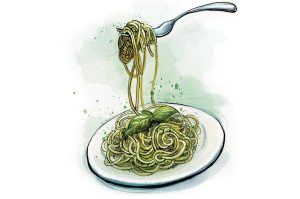First the Athletic, now Wordle. In case you missed it, the New York Times has bought Wordle for a couple of mil. Josh Wardle, the game’s creator, talks to TIME magazine about how he feels about the sale: “‘My biggest sense, actually, right now, isn’t joy. It’s relief,’ Josh Wardle, who was paid ‘in the low seven figures’ for the daily puzzle, told me by phone. It was our second conversation in as many days… when we met, Wardle had not wanted his photo taken, and was clearly worn down by the attention tsunami that a few days earlier had swept across the Great Plains to engulf a Canadian industrial equipment salesman with the same name: ‘Regina man mistaken for inventor of Wordle fielding flood of emails, CNN interview request’ was the headline on a CBC story. ‘I think if I was actually the creator,’ the Canadian Josh Wardle observed to a reporter, ‘I’d be quite exhausted.’”
Wardle had promised that the game would always be free. That’s unlikely now. In his story about the sale, Marc Tracy reports that the game “would initially remain free” at the Times. That makes sense. Why put the game behind a paywall while its popularity is still rising? The paywall will come once the game hits its peak.
No doubt the Times acquired Wordle to help build its New York Times Games, which requires a separate subscription, like New York Times Cooking and New York Times Wirecutter, the newspaper’s shopping site. If it ever decides to bring its tours back—called New York Times Journeys — one could almost live completely in the New York Times bubble and never leave. It just needs a dating app.
In other news
Shahidha Bari reviews a new book on the history of clothing: “Sofi Thanhauser offers a simple but remarkable fact early on in her new book, Worn: today it is more expensive to make your own clothes than to buy them. This is a relatively recent and shocking development in the history of human dress. How did such a situation come to pass?” And if you’ve got 45 minutes to spare, watch this documentary on the world’s oldest known pair of pants.
Henry James and the Great War:
In the final eighteen months of his life James found it difficult to work on his pre-war literary projects. In November 1914 he told Wharton: “I try myself to get back to work — but… I crawl like a fly — a more or less frozen fly — on a vast blank wall.” A month later he wrote Wharton again: “one of three books begun & abandoned”… The war affected James’s daily life. His valet Burgess Oakes enlisted. So did the sons of many friends. He knew several young writers who had enlisted, including Rupert Brooke. In February 1915 he visited Brooke, who was on sick leave. James promised Brooke, who died of sepsis two months later while on his way to Gallipoli, that he would write an introduction to Brooke’s letters from America (appearing in 1916, it was the last essay James wrote). In October 1915, James learned that the son-in-law of his neighbor Moreton Frewen had died in the war.
Proust’s À La Recherche Du Temps Perdu is funny. Why do so many people miss this, Nicola Shulman wonders.
Kyle Smith recommends a new documentary on Bill Cosby: “In the 1980s, Bill Cosby was perhaps the most beloved man in America. And yet for two decades before that, and many years after, he was a sexual predator, according to dozens of women. Did he give us sly signals about what he was up to along the way? We Need to Talk About Cosby, an outstanding four-hour documentary that debuted at the Sundance Film Festival last month and is now airing in four parts on Showtime, concludes that he did.”
Here’s your heartwarming story for the day:
During his Christmas break, Dillon Helbig, an eight-year-old boy from Boise, Idaho, wrote a book that he wanted everyone to read. He had spent a long time on it — four days to be exact — and filled eighty-one pages of an empty journal with a richly illustrated tale about how he gets transported back in time after a star atop his Christmas tree explodes. But he did not have a book deal. (He’s only in second grade, after all.) So when his grandmother took him to the Lake Hazel branch of the Ada Community Library in Boise at the end of December, he slipped the sole copy of his book onto a shelf containing fiction titles. “I had to sneak past the librarians,” said Dillon, who says “li-berry” instead of “library.” Over the next month, a series of circumstances made the book one of the library’s most sought-after titles and also inspired children in Boise to write their own stories. The book, “The Adventures of Dillon Helbig’s Crismis” by the author “Dillon His Self,” had drawn so much attention by the end of January that fifty-six people were on the waiting list to check it out.
The cult of Cage: “Cage has, for forty years onscreen, delivered performances of such furious spectacle that they transcend the humanity they represent. To see him react is to wonder if you’ve ever really felt, or could feel, anything so deeply, and if you’d want to.”
In the latest issue of The Spectator World, I write: “Lee Siegel’s defense of argument in the latest volume of Yale’s ‘Why X Matters’ series is original, provocative and frustrating, which isn’t bad for a book on argument.” Read the rest.





















